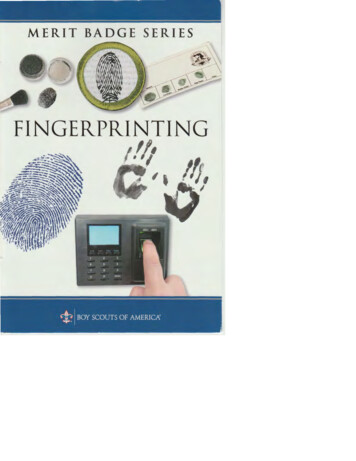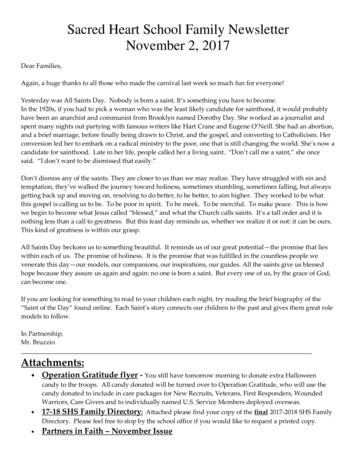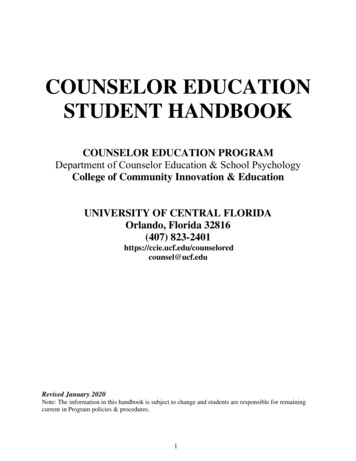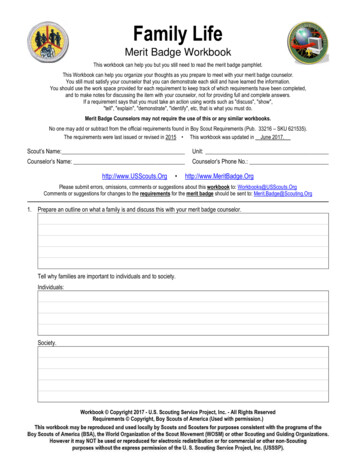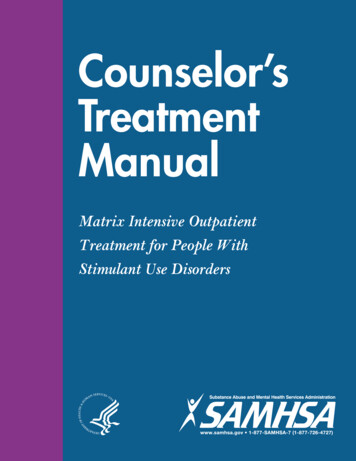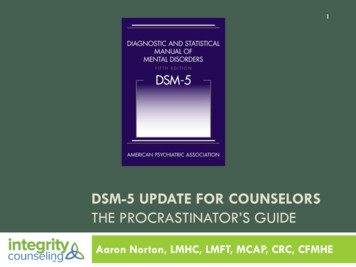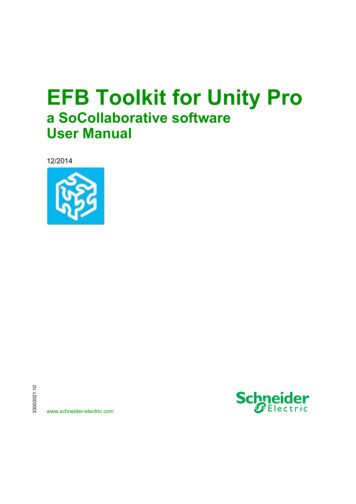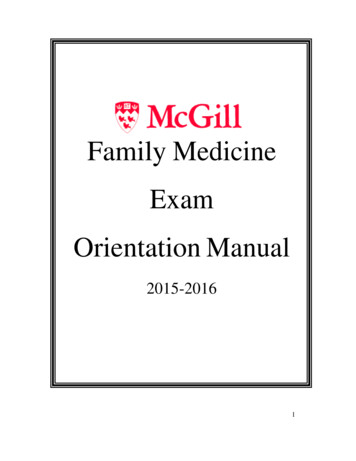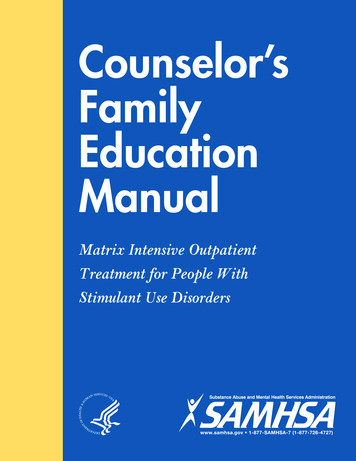
Transcription
Counselor’sFamilyEducationManualMatrix Intensive OutpatientTreatment for People WithStimulant Use Disorders
Please share your thoughts about this publication by completing a brief online survey at:https://www.surveymonkey.com/r/KAPPFSThe survey takes about 7 minutes to complete and is anonymous.Your feedback will help SAMHSA develop future products.
Counselor’s FamilyEducation ManualMatrix Intensive Outpatient Treatment forPeople With Stimulant Use DisordersU.S. DEPARTMENT OF HEALTH AND HUMAN SERVICESSubstance Abuse and Mental Health Services AdministrationCenter for Substance Abuse Treatment1 Choke Cherry RoadRockville, MD 20857
AcknowledgmentsNumerous people contributed to this document, which is part of the Methamphetamine Treatment Project (MTP).The document was written by Jeanne L. Obert, M.F.T., M.S.M.; Richard A. Rawson, Ph.D.; Michael J. McCann,M.A.; and Walter Ling, M.D. The MTP Corporate Authors provided valuable guidance and support on this document.This publication was developed with support from the University of California at Los Angeles (UCLA) CoordinatingCenter through Grant No. TI11440. MTP was funded by the Center for Substance Abuse Treatment (CSAT),Substance Abuse and Mental Health Services Administration (SAMHSA), U.S. Department of Health and HumanServices (HHS). The research was conducted from 1998 to 2002 in cooperation with the following institutions:County of San Mateo, San Mateo, CA (TI11411); East Bay Recovery Project, Hayward, CA (TI11484); FriendsResearch Institute, Inc., Concord, CA (TI11425); Friends Research Institute, Inc., Costa Mesa, CA (TI11443); SaintFrancis Medical Center of Hawaii, Honolulu, HI (TI11441); San Diego Association of Governments, San Diego, CA(TI11410); South Central Montana Regional Mental Health Center, Billings, MT (TI11427); and UCLA CoordinatingCenter, Los Angeles, CA (TI11440). The publication was produced by JBS International, Inc. (JBS), underKnowledge Application Program (KAP) contract numbers 270-99-7072 and 270-04-7049 with SAMHSA, HHS.Christina Currier served as the CSAT Government Project Officer. Andrea Kopstein, Ph.D., M.P.H., served as theDeputy Government Project Officer. Cheryl Gallagher, M.A., served as CSAT content advisor.DisclaimerThe views, opinions, and content of this publication are those of the authors and do not necessarily reflect theviews, opinions, or policies of SAMHSA or HHS.Public Domain NoticeAll material appearing in this report is in the public domain and may be reproduced or copied without permissionfrom SAMHSA. Citation of the source is appreciated. However, this publication may not be reproduced or distributedfor a fee without the specific, written authorization of the Office of Communications, SAMHSA, HHS.Electronic Access and Printed CopiesThis publication may be ordered or downloaded from SAMHSA’s Publications Ordering Web page athttp://store.samhsa.gov. Or, please call SAMHSA at 1-877-SAMHSA-7 (1-877-726-4727) (English and Español).Recommended CitationCenter for Substance Abuse Treatment. Counselor’s Family Education Manual: Matrix Intensive OutpatientTreatment for People With Stimulant Use Disorders. HHS Publication No. (SMA) 13-4153. Rockville, MD:Substance Abuse and Mental Health Services Administration, 2006.Originating OfficeQuality Improvement and Workforce Development Branch, Division of Services Improvement, Center forSubstance Abuse Treatment, Substance Abuse and Mental Health Services Administration, 1 Choke Cherry Road,Rockville, MD 20857.HHS Publication No. (SMA) 13-4153First printed 2006Revised 2007, 2010, 2011, 2012, and 2013ii
ContentsI. I ntroduction to the Matrix Intensive Outpatient Treatment for PeopleWith Stimulant Use Disorders Approach and Package. . . . . . . . . . . . . . . . . . . . 1Background. . . . . . . . . . . . . . . . . . . . . . . . . . . . . . . . . . . . . . . . . . . . . . . . . . . . . . . . . . . . . . . . . 1Matrix IOP Approach. . . . . . . . . . . . . . . . . . . . . . . . . . . . . . . . . . . . . . . . . . . . . . . . . . . . . . . . . . 2The Role of the Counselor . . . . . . . . . . . . . . . . . . . . . . . . . . . . . . . . . . . . . . . . . . . . . . . . . . . . . 5The Matrix IOP Package. . . . . . . . . . . . . . . . . . . . . . . . . . . . . . . . . . . . . . . . . . . . . . . . . . . . . . . 6Introduction to the Family Education Group. . . . . . . . . . . . . . . . . . . . . . . . . . . . . . . . . . . . . . . . 7II. Session Instructions. . . . . . . . . . . . . . . . . . . . . . . . . . . . . . . . . . . . . . . . . . . . 11Family Education Sessions Overview . . . . . . . . . . . . . . . . . . . . . . . . . . . . . . . . . . . . . . . . . . . 11Session 1: Triggers and Cravings (PowerPoint Presentation). . . . . . . . . . . . . . . . . . . . . . . . . 13Session 2: Alcohol and Recovery (PowerPoint Presentation) . . . . . . . . . . . . . . . . . . . . . . . . . 21Session 3: Recovery (Panel Presentation). . . . . . . . . . . . . . . . . . . . . . . . . . . . . . . . . . . . . . . . 30Session 4: Methamphetamine and Cocaine (PowerPoint Presentation) . . . . . . . . . . . . . . . . . 31Session 5: Roadmap for Recovery (PowerPoint Presentation) . . . . . . . . . . . . . . . . . . . . . . . . 43Session 6: Coping With the Possibility of a Relapse (Multifamily Group Discussion) . . . . . . . 56Session 7: Opioids and Club Drugs (PowerPoint Presentation). . . . . . . . . . . . . . . . . . . . . . . . 58Session 8: Families in Recovery (PowerPoint Presentation). . . . . . . . . . . . . . . . . . . . . . . . . . 67Session 9: Rebuilding Trust (Multifamily Group Discussion) . . . . . . . . . . . . . . . . . . . . . . . . . . 77Session 10: Marijuana (PowerPoint Presentation). . . . . . . . . . . . . . . . . . . . . . . . . . . . . . . . . . 78Session 11: Living With an Addiction (Multifamily Group Discussion). . . . . . . . . . . . . . . . . . . 84Session 12: Communication Traps (Multifamily Group Discussion). . . . . . . . . . . . . . . . . . . . . 85III. Family Education Handouts . . . . . . . . . . . . . . . . . . . . . . . . . . . . . . . . . . . . . 89AppendicesAppendix A. The Methamphetamine Treatment Project. . . . . . . . . . . . . . . . . . . . . . . . . . . . . 155Appendix B. Notes on Group Facilitation . . . . . . . . . . . . . . . . . . . . . . . . . . . . . . . . . . . . . . . . 157Appendix C. Acronyms and Abbreviations List. . . . . . . . . . . . . . . . . . . . . . . . . . . . . . . . . . . . 159Appendix D. Field Reviewers . . . . . . . . . . . . . . . . . . . . . . . . . . . . . . . . . . . . . . . . . . . . . . . . . 161Appendix E. Bibliography . . . . . . . . . . . . . . . . . . . . . . . . . . . . . . . . . . . . . . . . . . . . . . . . . . . . 163Appendix F. Acknowledgments. . . . . . . . . . . . . . . . . . . . . . . . . . . . . . . . . . . . . . . . . . . . . . . . 167iii
This page intentionally left blank.
I. Introduction to the Matrix IntensiveOutpatient Treatment for PeopleWith Stimulant Use DisordersApproach and PackageThe Matrix Intensive Outpatient Treatment forPeople With Stimulant Use Disorders (IOP) package provides a structured approach for treatingadults who abuse or are dependent on stimulantdrugs. The approach followed in the treatmentpackage was developed by the Matrix Institute inLos Angeles, California, and was adapted for thistreatment package by the Knowledge ApplicationProgram of the Center for Substance AbuseTreatment of the Substance Abuse and MentalHealth Services Administration (SAMHSA). TheMatrix IOP package comprises five components: Counselor’s Treatment Manual Counselor’s Family Education Manual(this document) CD-ROM that accompanies theCounselor’s Family Education Manual Client’s Handbook Client’s Treatment CompanionThe Matrix IOP model and this treatment package based on that model grew from a need forstructured, evidence-based treatment for clientswho abuse or are dependent on stimulant drugs,particularly methamphetamine and cocaine. Thiscomprehensive package provides substanceabuse treatment professionals with a yearlongintensive outpatient treatment model for theseclients and their families: 16 weeks of structuredprogramming and 36 weeks of continuing care.BackgroundThe Matrix IOP method was developed initially inthe 1980s in response to the growing numbersof individuals entering the treatment system withcocaine or methamphetamine dependence astheir primary substance use disorder. Manytraditional treatment models then in use weredeveloped primarily to treat alcohol dependenceand were proving to be relatively ineffective intreating cocaine and other stimulant dependence(Obert et al. 2000).To create effective treatment protocols for clients dependent on stimulant drugs, treatmentprofessionals at the Matrix Institute drew fromnumerous treatment approaches, incorporatinginto their model methods that were empiricallytested and practical. Their treatment modelincorporated elements of relapse prevention,cognitive–behavioral, psychoeducation, andfamily approaches, as well as 12-Step programsupport (Obert et al. 2000).The effectiveness of the Matrix IOP approachhas been evaluated numerous times since itsinception (Rawson et al. 1995; Shoptaw et al.1994). SAMHSA found the results of these studies promising enough to warrant further evaluation (e.g., Obert et al. 2000; Rawson et al. 2004).In 1998, SAMHSA initiated a multisite study oftreatments for methamphetamine dependence1
Counselor’s Family Education Manual: Matrix Intensive Outpatient Treatmentand abuse, the Methamphetamine TreatmentProject (MTP). The study compared the clinicaland cost effectiveness of a comprehensivetreatment model that follows a manual developed by the Matrix Institute with the effectiveness of treatment approaches in use at eightcommunity-based treatment programs, includingsix programs in California, one in Montana, andone in Hawaii. Appendix A provides more information about MTP.Matrix IOP ApproachOverviewThe Matrix IOP approach provides a structuredtreatment experience for clients with stimulant usedisorders. Clients receive information, assistancein structuring a substance-free lifestyle, and support to achieve and maintain abstinence fromdrugs and alcohol. The program specificallyaddresses the issues relevant to clients who aredependent on stimulant drugs, particularlymethamphetamine and cocaine, and their families.For 16 weeks, clients attend several intensiveoutpatient treatment sessions per week. Thisintensive phase of treatment incorporates various counseling and support sessions: Individual/Conjoint family sessions(3 sessions) Early Recovery Skills group sessions(8 sessions) Relapse Prevention group sessions(32 sessions) Family Education group sessions(12 sessions) Social Support group sessions(36 sessions)2Clients may begin attending the fifth type ofcounseling session, continuing care (SocialSupport groups), once they have completed the12-session Family Education group but are stillattending Relapse Prevention group sessions.Overlapping Social Support group attendancewith the intensive phase of treatment helpsensure a smooth transition to continuing care.The Matrix IOP method also familiarizes clientswith 12-Step programs and other support groups,teaches clients time management and scheduling skills, and entails conducting regular drugand breath-alcohol testing. A sample schedule oftreatment activities is shown in Figure I-1.Program ComponentsThis section describes the logistics and philosophy of each of the five types of counselingsessions that are components of the Matrix IOPapproach. Detailed agendas and instructions forconducting each type of group and individualsession are provided in this manual and in theCounselor’s Treatment Manual.The Matrix materials use step-by-step descriptions to explain how sessions should be conducted. The session descriptions are methodicalbecause the treatment model is intricate anddetailed. Counselors who use these materials may want additional training in the Matrixapproach, but these materials were designed sothat counselors could implement the Matrix treatment approach even without training. The Matrixmaterials do not describe intake procedures,assessments, or treatment planning. Programsshould use the procedures they have in placeto perform these functions. If the guidelines presented in this manual conflict with the requirements of funders or credentialing or certifyingbodies, programs should adapt the guidelinesas necessary. (For example, some Statesrequire that sessions last a full 60 minutes tobe funded by Medicaid.)
I. IntroductionFigure I-1. Sample Matrix IOP aySaturday andSundayIntensive TreatmentWeeks 1 through 4*6:00–6:50 p.m.Early Recovery Skills7:15–8:45 p.m.Relapse Prevention12-Step/mutual-helpgroup meetings7:00–8:30 p.m.Family Education12-Step/mutual-helpgroup meetings6:00–6:50 p.m.Early Recovery Skills7:15–8:45 p.m.Relapse Prevention12-Step/mutual-helpgroup meetingsIntensive TreatmentWeeks 5 through 16†Continuing CareWeeks 13 through 487:00–8:30 p.m.Relapse PreventionNothing scheduled12-Step/mutual-helpgroup meetings12-Step/mutual-helpgroup meetings7:00–8:30 p.m.Family Educationor7:00–8:30 p.m.Social Support7:00–8:30 p.m.Social Support12-Step/mutual-helpgroup meetings12-Step/mutual-helpgroup meetings7:00–8:30 p.m.Relapse PreventionNothing scheduled12-Step/mutual-helpgroup meetings12-Step/mutual-helpgroup meetings* 1 Individual/Conjoint session at week 1† 2 Individual/Conjoint sessions at week 5 or 6 and at week 16All Matrix IOP groups are open ended, meaningthat clients may begin the group at any pointand will leave that group when they have completed the full series. Because the Matrixgroups are open ended, the content of sessionsis not dependent on that of previous sessions.The counselor will find some repetition of information among the three Individual/Conjoint sessions as well as group sessions. Clients in earlyrecovery often experience varying degrees ofcognitive impairment, particularly regardingshort-term memory. Repeating information indifferent ways, in different group contexts, andover the course of clients’ treatment helpsclients comprehend and retain basic conceptsand skills critical to recovery.Individual/Conjoint SessionsIn the Matrix IOP intervention, the relationshipbetween counselor and client is consideredthe primary treatment dynamic. Each client isassigned one primary counselor. That counselormeets individually with the client and possiblythe client’s family members three times duringthe intensive phase of treatment for three 50minute sessions and facilitates the EarlyRecovery Skills and Relapse Prevention groups.3
Counselor’s Family Education Manual: Matrix Intensive Outpatient TreatmentThe first and last sessions serve as “bookends”for a client’s treatment (i.e., begin and end treatment in a way that facilitates treatment engagement and continuing recovery); the middle session is used to conduct a quick, midtreatmentassessment of the client’s progress, to addresscrises, and to coordinate treatment with othercommunity resources when appropriate.Conjoint sessions that include both the client andfamily members or other supportive persons arecrucial to keeping clients in treatment. The importance of involving people who are in a primaryrelationship with the client cannot be overestimated; the Matrix IOP approach encourages theinclusion of a client’s most significant familymember or members in each Individual/Conjointsession in addition to Family Education groupsessions. The counselor who tries to facilitatechange in client behavior without addressingfamily relationships ultimately makes the recovery process more difficult. It is critical for thecounselor to stay aware of how the recoveryprocess affects the family system and to includea significant family member in part of everyIndividual/Conjoint session when possible.Early Recovery Skills GroupClients attend eight Early Recovery Skills(ERS) group sessions—two per week for thefirst month of primary treatment. These sessionstypically involve small groups (10 people maximum) and are relatively short (50 minutes).Each ERS group is led by a counselor and coled by a client who is advanced in the programand has a stable recovery (see pages 7–8 inthe Counselor’s Treatment Manual for information about working with client co-leaders). It isimportant that this group stay structured andon track. The counselor needs to focus on thesession’s topic and be sure not to contribute tothe high-energy, “out-of-control” feelings thatmay be characteristic of clients in early recoveryfrom stimulant dependence.4The ERS group teaches clients an essential setof skills for establishing abstinence from drugsand alcohol. Two fundamental messages aredelivered to clients in these sessions:1. You can change your behavior in ways thatwill make it easier to stay abstinent, and theERS group sessions will provide you withstrategies and practice opportunities.2. Professional treatment can be one sourceof information and support. However, tobenefit fully from treatment, you also need12-Step or mutual-help groups.The techniques used in the ERS group sessions are behavioral and have a strong “how to”focus. This group is not a therapy group, nor isit intended to create strong bonds among groupmembers, although some bonding often occurs.It is a forum in which the counselor can workclosely with each client to assist the client inestablishing an initial recovery program. EachERS group has a clear, definable structure. Thestructure and routine of the group are essentialto counter the high-energy or out-of-control feelings noted above. With newly admitted clients,the treatment routine is as important as theinformation discussed.Relapse Prevention GroupThe Relapse Prevention (RP) group is a central component of the Matrix IOP method. Thisgroup meets 32 times, at the beginning andend of each week during the 16 weeks of primary treatment. Each RP group session lastsapproximately 90 minutes and addresses aspecific topic. These sessions are forums inwhich people with substance use disordersshare information about relapse prevention andreceive assistance in coping with the issues ofrecovery and relapse avoidance. The RP groupis based on the following premises:
I. Introduction Relapse is not a random event. The process of relapse follows predictablepatterns. Signs of impending relapse can beidentified by staff members and clients.The RP group setting allows for mutual clientassistance within the guiding constraints provided by the counselor. Clients heading towardrelapse can be redirected, and those on asound course to recovery can be encouraged.The counselor who sees clients for prescribedIndividual/Conjoint sessions and a client co-leaderfacilitate the RP group sessions (see pages 7–8in the Counselor’s Treatment Manual for information about working with client co-leaders).Examples of the 32 session topics covered inthe RP group include Guilt and shame Staying busy Motivation for recovery Be smart, not strong Emotional triggersgroup sessions once per week for 36 weeks ofcontinuing care. For 1 month, intensive treatment and continuing care overlap.Social Support group sessions help clientslearn or relearn socialization skills. Persons inrecovery who have learned how to stop usingsubstances and how to avoid relapse are readyto develop a substance-free lifestyle that supports their recovery. The Social Support groupassists clients in learning how to resocialize withclients who are further along in the program andin their recovery in a familiar, safe environment.This group also is beneficial to the experiencedparticipants who often strengthen their ownrecovery by serving as role models and stayingmindful of the basic tenets of abstinence. Thesegroups are led by a counselor, but occasionally they may be broken into smaller discussiongroups led by a client–facilitator, a client with astable recovery who has served as a co-leaderand makes a 6-month commitment to assistthe counselor.Social Support group sessions focus on a combination of discussion of recovery issues beingexperienced by group members and discussionof specific, one-word recovery topics, such asFamily Education Group PatienceThe chances of treatment success increaseimmensely if significant others become educatedabout the predictable changes that are likely tooccur within relationships as recovery proceeds.The primary counselor educates participants andencourages involvement of significant others, aswell as clients, in the 12-session Family Educationgroup. The Family Education group is discussedin depth on page 7. IntimacySocial Support Group (Continuing Care)Clients begin attending the Social Supportgroup at the beginning of their last month ofprimary treatment and continue attending these Isolation Rejection WorkThe Role of the CounselorTo implement the Matrix IOP approach thecounselor should have several years of experience working with groups and individuals.Although detailed instructions for conductingsessions are included in this manual, a new5
Counselor’s Family Education Manual: Matrix Intensive Outpatient Treatmentcounselor may not have acquired the facility orthe skills necessary to make the most of the sessions. The counselor who is willing to adapt andlearn new treatment approaches is an appropriate Matrix IOP counselor. The counselor whohas experience with cognitive–behavioral andmotivational approaches and has a familiaritywith the neurobiology of addiction will be bestprepared to implement Matrix IOP intervention. Appropriate counselor supervision will helpensure fidelity to the Matrix treatment approach.aware of all aspects of their treatment. Manypeople who are stimulant dependent enter treatment feeling out of control. They are looking tothe program to help them regain control. If theprogram appears to be a disjointed series ofunrelated parts, these clients may not feel thatthe program will help them regain control, whichmay lead to unsuccessful treatment outcomesor premature treatment termination. Appendix Bprovides more notes on the counselor’s role infacilitating Family Education groups.In addition to conducting the three Individual/Conjoint sessions, a client’s primary counselordecides when a client moves from one group toanother and is responsible for integrating material from the various group-counseling formatsinto one coordinated treatment experience.The Matrix IOP PackageEach client’s primary counselor Coordinates with other counselors work-ing with the client in group sessions (e.g.,in the Family Education sessions) Is familiar with the material to which theclient is being exposed in the FamilyEducation sessions Encourages, reinforces, and discussesmaterial that is being covered in 12-Stepor mutual-help meetings Helps the client integrate concepts fromtreatment with 12-Step and mutual-helpmaterial, as well as with psychotherapy orpsychiatric treatment (for clients who arein concurrent therapy) Coordinates with other treatment or socialservices professionals who are involvedwith the clientIn short, the counselor coordinates all thepieces of the treatment program. Clients needthe security of knowing that the counselor is6In addition to this Counselor’s Family EducationManual (introduced in detail on page 7), the MatrixIOP package consists of these components: Counselor’s Treatment Manual—TheCounselor’s Treatment Manual containsall the materials necessary for a counselor to conduct the Individual/Conjoint sessions and ERS, RP, and Social Supportgroups. It is organized by type of groupsession; each section begins with anoverview that includes a discussion of The overall goals for each type of groupsession The general format and counselingapproach of the sessions Special considerations relevant to aparticular type of group session The overview is followed by instructionsfor conducting each session. Copies ofthe handouts that make up the Client’sHandbook are at the end of each section’s instructions for easy reference. Client’s Handbook—This illustratedhandbook contains an introduction andwelcome and all the handouts that areused in the Matrix IOP program, except
I. Introductionfor those used in the Family Educationgroup sessions. Individual handoutsare used for Family Education sessionsbecause family members attend thisgroup with clients and do not have thehandouts from the Client’s Handbook. Client’s Treatment Companion—TheClient’s Treatment Companion is forclients to carry with them in a pocket orpurse. It contains useful recovery toolsand concepts and provides space forclients to record their relapse triggers andcues, write short phrases that help themresist triggers, and otherwise personalizethe book. Ideas are included for waysto personalize and make the Client’sTreatment Companion a useful toolfor recovery.Introduction to the FamilyEducation GroupOverviewPeople with substance use disorders often findthemselves isolated from their families or inongoing conflict with family members. Familymembers (including extended family members)and significant others may experience feelingsof abandonment, anxiety, fear, anger, concern,embarrassment, or guilt. Family members oftendo not understand substance use disorders andthe changes that have occurred in their family.They also may not understand the dynamics ofrecovery and the changes that recovery brings.Providing education about substance use disorders and recovery and an opportunity for familymembers to talk about their concerns is criticalto helping them support the person who is intreatment and can alleviate anxiety and othernegative feelings they may have.Education helps families change some behaviorsthat are common to families coping with peoplewho have a substance use disorder (such asprotecting people who are dependent on substances from the consequences of their dependence). These behaviors may be disruptiveboth to people in treatment and to their familymembers. In addition, having some idea of whatto expect as their loved ones progress in theirrecovery helps family members adjust to changesthat accompany recovery. Treatment is morelikely to succeed if significant others becomeeducated about the predictable changes thatoccur within the relationship as recovery proceeds. In addition to providing specific education,the Family Education group sessions provide thecounselor with an opportunity to facilitate involvement of significant others in clients’ recovery.Substance abuse can place families in crisis.Counselors should be mindful that violence canerupt in this kind of environment. A concern forthe safety of clients and the family membersinvolved in treatment should be foremost in thecounselor’s mind.The Family Education group is not familytherapy and does not attempt direct interventioninto individual familial dynamics. Rather, theFamily Education component of the Matrix IOPpackage takes a psychoeducational approach.It provides a relatively nonthreatening environment in which to present information and anopportunity for clients and their families to feelcomfortable and welcome in the treatment facility.Information is presented about methamphetamine dependence, other drug and alcohol use,treatment, recovery, the ways in which familiesare affected by a client’s drug use and dependence, and how family members can support aclient’s recovery.Matrix treatment experience shows that, ifclients are involved closely with significantothers, those significant others are part of therecovery process regardless of whether thoseothers are involved in treatment activities.Because the interactions in clients’ families7
Counselor’s Family Education Manual: Matrix Intensive Outpatient Treatmentbefore clients begin treatment often can benegative, clients may be adamant that theyneed to “do my program alone.” The counselorcan work with clients to help them understandthe importance of involving their families intreatment, but if clients continue to resist familymembers’ participation, the counselor shouldnot insist.It is common for family members to believe that“it’s not my problem.” They may be angry andunwilling to involve themselves in the client’streatment. Therefore, the counselor personallyinvites family members to attend the sessions andcarefully explains the potential value of attending.When deciding who should be included in theFamily Education group, programs should usea definition of “family” that accommodatesimportant people in a particular client’s life. Forexample, a long-term romantic partner should beconsidered family whether the partner is marriedto the client or not. A client may also consider aclose friend or mentor as family. Older adolescents may be appropriate for the program, butthe Family Education group cannot accommodate and is not useful for younger children.Programs should consider offering child careduring group sessions to facilitate familymembers’ attendance.All clients attend Family Education group sessions whether their family members or significantothers attend. These group sessions provide thestructured educational component of treatmentfor clients. In addition, clients receive informationabout the dynamics of family relationships asthey relate to substance use disorders.The counselor facilitating Family Educationgroup sessions should be sensitive to culturaland other diversity issues relevant to the specificpopulations being served. The counselor needsto understand culture in broad terms that8include not only obvious markers such as race,ethnicity, and religion, but also socioeconomicstatus, level of education, and level of acculturation to U.S. society. The counselor shouldexhibit a willingness to understand clients withinthe context of their culture. However, it also isimportant to remember that each client is anindividual, not merely an extension of a particularculture. Cultural backgrounds are compl
Family Education group sessions (12 sessions) Social Support group sessions (36 sessions) Clients may begin attending the fifth type of counseling session, continuing care (Social Support groups), once they have completed the 12-session Family Education group b
